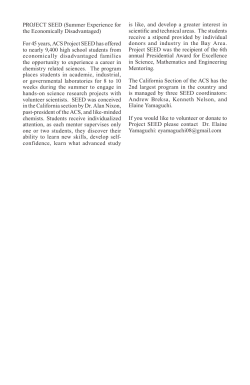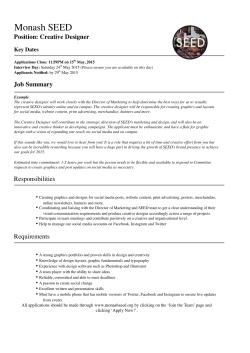
Seed and oil quality characteristics of some castor
International Journal of Agriculture, Environment and Biotechnology Citation: IJAEB: 8(1): 177-181 March 2015 DOI Number: 10.5958/2230-732X.2015.00023.6 ©2015 New Delhi Publishers. All rights reserved 22 AGRONOMY Seed and oil quality characteristics of some castor (Ricinus Communis L.) inbred lines S.K. Shah*, D.K. Patel, R.M. Patel and P.S. Patel S.D. Agricultural University, Main Castor Mustard Research Station, Sardarkrushinagar Dist. B.K. (Gujarat) 385 506, India. *Corresponding author: sarveshshah@gmail.com Paper No. 307 Received: 16 January 2015 Accepted: 2 March 2015 Published: 25 March 2015 ABSTRACT Castor (Ricinus communis L) is an important non-edible oilseed crop with diversified industrial usage. India is dominating in the production and productivity of castor. Thirteen inbred lines were studied for seed physical characteristics, oil quality, as well as fatty acid profile. Among the inbred studied, the maximum weight of 100 seed was 34.2 g, in JC-26, and maximum oil content was 51.3% in SKI-333. One hundred seed wt showed a positive correlation with % of kernel (r=0.472*) and seed oil content has positive correlation with kernel oil content (r=0.803**). Important oil characteristics for industrial use like specific gravity (g/cc) varied from 0.954 to 0.958 while the viscosity (cp) ranged from 604 to 626. The free Fatty acid as oleic acid was ranging between 4.33 to 6.02%. Among the fatty acid, the ricinolic acid was ranging from 83.93 to 87.02%, the minimum value was in 48-1 while the maximum value of ricinolic acid was recorded in DCS-9 inbred. Highlights • Screening for inbreds for quality parameters are useful in further hybridization and variety development. • Ricinolic acid of inbreds were between 84 to 87%. Keywords: Castor inbred lines, ricinolic acid, fatty acid, oil quality Castor (Ricinus communis L) belongs to Euphorbiaceae family is cultivated commercially in the arid and semi arid region of the world. The latest statistics shows that worldwide castor is grown on a total area of 1.68 m ha with a production of 2.65 m tons (or 1.3 m tons of castor oil). During 2011, India produced 2.34 million tons of castor seed, while second and third largest producer countries, China and Brazil produced 0.18 and 0.12 million tons, respectively (FAOSTAT, 2013). Due to massive agricultural research and development in and use of improved agro technologies by the farmers, India is leading in the production and productivity of castor in the world. In India, the castor crop has witnessed a number of transformations under varietal improvement (from perennial to annual type) but the real through in the production and productivity of castor was achieved after introduction of castor hybrids. Due to intensive hybridization and selection programme aiming to further improve in yield and quality of castor, a large number of inbred lines have been developed. These inbred lines are of much use in further hybridization and variety development process. Shah et.al. Table 1. Seed physical characteristics and oil quality of castor genotypes 100 Seed wt. (gm) Seed oil content (%) Kernel oil content (%) Kernel (%) Seed coat (%) JC-20 31.2 50.1 63.6 72.6 27.4 Specific gravity (g/Cc) at 25°C 0.955 JC-4 31.9 50.3 62.4 71.3 28.7 DCS-9 (C) 27.6 48.2 60.1 69.9 JC-22 33.7 50.8 63.4 70.2 SKI-333 31.4 51.3 63.6 JC-24 29.9 49.0 SKI-339 26.8 46.6 JC-26 34.2 JC-12 48-1 (C ) Genotypes Refractive Index (nd) at 25°C Viscosity Colour (cp) at value (Y+R) 25°C 1.476 620 1.0+0.5 0.956 1.477 607 1.0+1.0 30.1 0.958 1.476 615 0.7+0.1 29.8 0.956 1.476 618 1.0+0.4 66.7 33.3 0.954 1.474 625 0.6+0.1 61.1 66.8 33.2 0.956 1.475 614 0.9+0.3 60.8 68.2 31.8 0.956 1.468 615 0.8+1.0 49.6 61.9 69.6 30.4 0.955 1.475 626 0.5+0.6 31.0 49.5 62.1 69.3 30.7 0.957 1.458 621 1.0+0.3 30.7 51.0 63.6 72.0 28.0 0.956 1.477 613 1.0+0.4 MCI-11 32.2 50.7 61.8 72.5 27.5 0.957 1.477 605 1.0+0.6 MCI-12 27.1 50.7 62.8 70.9 29.1 0.957 1.477 610 1.0+0.7 GC-3 (LC) 31.2 49.8 63.1 73.0 27.0 0.956 1.477 604 0.6+0.9 Mean 30.7 49.8 62.3 70.2 29.8 1.0 1.5 615 SEM 00.6 0.4 0.3 0.6 0.6 0.0 0.0 2.0 SD 2.3 1.3 1.2 2.1 2.1 0.0 0.0 7.1 26.8-34.2 46.6-51.3 60.1-63.6 66.7-73.0 27.0-33.3 0.954-958 1.458-1.477 604.0626.0 Range Min Castor oil is a pale amber viscous liquid derived from the seeds. Castor oil is non edible but very important for industrial use and is characterized by its high viscosity, specific gravity and acetyl value. The ricinolic acid (12-hydroxy-9-octadecenoic acid) is the principal component of castor oil, which account for up to 80-95 % of the total fatty acid and is responsible for the high viscosity and other peculiar characteristic of this oil. Presence of hydroxyl groups and double bonds makes the oil suitable for many chemical reactions and modifications to make various value added products (Ogunniyi, 2006). The castor oil and its fatty acids composition is affected by the edaphological characteristics (Abolfazl Alirezalu et al., 2011). Considerable variations in fatty acids composition have been found due to differences in the genotypes and the growing conditions. Looking to the importance of inbred lines in the breeding programmes, thirteen inbred lines were studied for seed physical characteristics, oil quality and fatty acid composition. Materials and Methods Thirteen castor inbred lines namely, JC-20, JC-4, DCS-9, JC-22, SKI-333, JC-24, SKI-339, JC-26, JC-12, 48-1, MCI-11, MCI-12, GC-3 were grown in Kharif 2011 with spacing of 120 cm Χ 60 cm, in RBD with three replications, under irrigated field conditions at Main Castor Mustard Research Station in Entisols of Sardarkrushinagar Dantiwada Agricultural University, Sardarkrushinagar (Gujarat, INDIA). Standard agronomic practices were followed to raise the crop. The castor crop was fertilized with 12025-0 NPK Kg/ha, as per recommended package of practices. The soil characteristics were pH (1:2.5): 7.7, Avail. N (Kg/ha): 192; Avail. P2O5 (Kg/ha): 49; Avail. K2O (Kg/ha): 283. The seeds were harvested at physiological maturity and analyzed for seed physical properties viz. 100 seeds weight (g), seed oil content (%), kernel oil content (%), kernel (%), seed coat (%). The castor seed oil was extracted according to the method described in AOCS (Aa 4-38), on soxlet 178 Seed and oil quality characteristics of some castor (Ricinus Communis L.) inbred lines Table 2 Fatty acid composition of the oil of castor genotypes Genotypes % free fatty acid as Oleic acid JC-20 2.38 JC-4 1.07 1.27 1.29 4.78 4.75 0.97 85.76 DCS-9 (C) 2.31 1.02 1.27 4.33 4.82 0.77 87.02 JC-22 1.32 1.42 1.31 4.98 4.82 1.14 85.30 SKI-333 1.16 1.39 1.32 5.63 4.71 1.19 84.26 JC-24 1.62 1.27 1.29 4.89 4.88 1.00 86.93 SKI-339 2.72 1.24 1.32 5.95 4.80 1.25 86.01 JC-26 1.24 1.38 1.34 4.54 4.81 1.12 86.17 JC-12 2.04 1.25 1.30 4.78 4.72 0.97 86.48 48-1 (C ) 1.44 1.38 1.30 5.85 4.72 1.08 83.93 MCI-11 1.04 1.81 1.30 4.87 4.84 0.91 86.69 MCI-12 1.72 1.32 1.30 5.35 4.75 1.05 85.83 GC-3 (LC) 1.51 1.36 1.30 6.02 4.72 1.11 84.56 Mean 1.70 1.30 1.30 5.2 4.8 1.1 85.70 SEM 0.2 0.0 0.0 0.2 0.0 0.0 0.3 SD Range C18:0 Stearic 1.35 Fatty acid composition (%) C18:2 C18:1 Oleic Linoleic 5.24 4.72 C16:0 Palmitic 1.41 C18:3 Linolenic 1.26 C18:1 (OH) Ricinoleic 85.10 0.5 0.2 0.0 0.6 0.1 0.1 1.0 1.04-2.72 1.02-1.81 1.27-1.35 4.33 6.02 4.71-4.88 0.77 1.26 83.93 87.02 apparatus (AOCS, 1951). Viscosity was determined using viscometer (A&N Vibro Viscometer, Model SV 10) and the colour value was determined using a Lovibond tintometer with one inch cell (Carson, 1995). The other oil quality parameters like specific gravity and refractive index were determined as per standard methods (AOAC 1990. The fatty acid profile was determined on FT-NIR (Bruker Optics-IFS MPA System). Correlation coefficient was calculated for the variables studied. Results and Discussion Seed quality parameters The seed quality parameters are the most important traits which determine the price of seeds at the time of sale. Among the inbred studied, the highest value of 100 seed wt 34.2 g was determined in JC-26 inbred line and the lowest value of 26.8 g was observed in SKI-339 inbred (Table 1). Seed weight is considered as key characteristic for milling. The highest value of seed oil content was determined in SKI-333 which was 51.3 % and the lowest value of 46.6 % was observed in SKI-339 inbred. The study reveals that among inbred studied, the difference of the oil content was 10.1 %. This might be a result mainly of genotypic variability. The values of oil content resembled with the findings of Lavanya (2012). The highest kernel oil content was determined in SKI333 inbred which was 63.6 % and the lowest value of 60.1 % was observed in DSC-9. The kernel oil content is significantly positively correlated with seed oil content (r=0.803**). The highest value of kernel was determined in GC-3 which was 73.0 % and the lowest value of 66.7 % was observed in SKI-333. Under the present study the seed coat had highly significant negative correlation with kernel % (r=-1.000**). Lower value of seed coat % is desirable character for better oil recovery (Moskin, 1986). 179 Shah et.al. Oil quality parameters: Among the castor inbred lines studied, specific gravity and refractive index varied from 0.954 to 0.958 and from 1.458 to 1.477, respectively. The values of specific gravity were in line with the findings of Abitogun et al., (2009). The value of refractive index is an indication of the level of saturation of the oil. The variation was attributed to differences in inbreds, planting and harvesting conditions, and extraction of the oil (Akpan et al., 2006). The viscosity of castor oil was in the range of 604 to 626 centipoise. The hydroxy group of recinolic acid imparts a very high degree of viscosity and oxidative stability which was four times more stable than the olive oil (Patel et al., 2004). The oil is mainly used as a lubricant because of its property to remain liquid at very low temperatures (-32°C), high density and viscosity (18 times that of other vegetables oil) (Nagraj, 1995). The colour of crude castor oil was yellow to brown and the value was in the range of 0.5 to 1.0. The variation in oil colour is attributed to the colour of seed hull. For different industrial utilization, colourless oil is preferred. Industry could take benefit of the natural colour value of the oil for different uses. The high value was as a result of the presence of high quantity of red pigment. The viscosity was negatively correlated with specific gravity (r = -0.595*). Among the fatty acid profiles, the variability for palmitic, stearic, oleic, linoleic, linolenic and ricinolic fatty acids were also recorded. The saturated fatty acids, palmitic and stearic were in the range of 1.02 to 1.81% and 1.27 to 1.35%, respectively. Stearic acid had significant negative correlation with the specific gravity (r=-0.828**) and positive with viscosity (r = 0562*). Mono unsaturated fatty acid- oleic acid varied from 4.33% (DSC-9) to 6.02% (GC-3). Higher value of oleic acid is a desirable trait for high oxidative stability, hence for suitability of castor oil for biodiesel or pharmaceutical application (Rojas et al., 2004). The poly unsaturated fatty acid like linoleic and linolenic were in the range of 4.71 to 4.88 and 0.77 to 1.26%, respectively. Linolenic fatty acid was significantly positively correlated with stearic (r= 0.828**) and oleic (r=0.650*) fatty acids . Ricinoleic acid, the predominant mono unsaturated fatty acid varied among castor inbreds from 83.93 (48-1) to 87.02% (DCS-9). The fatty acid profile resembled with the findings of Lakshminarayana et al., (1984).The functional group causes ricinoleic acid to be unusually polar and also allows chemical derivatization that is not practically possible with most other vegetable oils. It is the hydroxyl group which makes castor oil ricinoleic acid valuable as chemical feed stocks. Under the present study the ricinolic acid content was significantly negatively correlated with oleic fatty acid (r=-0.735**); and linolenic fatty acid (r=-0.609*), while positive with linoleic fatty acid (r=0.725**). Fatty acid profile: The quality of oil is a function of its fatty acid composition (Table 2). The value of free fatty acid as oleic acid varied from 1.04 % (MCI-11) to 2.72 % (SKI-339). The free fatty acid was negatively correlated with 100 seed wt (r = -0.688**) and seed oil content (r = -0.753**). This could be used to check the level of oxidative deterioration of the oil by enzymatic or chemical oxidation. The fire, flash and smoke points of the oil has linear relationship with the content of the free fatty acid present in the oil (AOAC, 1990), which is a good indicator of the advantageous utilization of the oil in soap making. A good quality castor oil should have the acid value within the range of 3-4 (Kulkarni and Ramanamurthy, 1977). Expelled castor oil has generally low fat acidity (<3), while solvent extracted oils has higher acid value than the required standard. Conclusion On the basis of studying thirteen inbred lines for seed physical characteristics, oil quality, as well as fatty acid profile, it was found that among the inbreds, the maximum weight of 100 seed was 34.2 g in JC-26, while maximum oil content was 51.3% in SKI-333. One hundred seed wt showed a positive correlation with % of kernel (r=0.472*) and seed oil content has positive correlation with kernel oil content (r=0.803**). The maximum value of ricinolic acid was 87.02 % recorded in DCS-9 inbred. The present study is of vital for selecting male parent for developing castor hybrids. 180 Seed and oil quality characteristics of some castor (Ricinus Communis L.) inbred lines References Abitogun A, Alademeyin O, Oloye D (2009) Extraction and characterization of castor seed oil. The Internet Journal of Nutrition and Wellness 8(2) doi: 10.5580/147f. Abolfazl Alirezalu, Nasrin Farhadi, Habib Shirzad, Saeid Hazarti (2011) The effect of climatic factors on the production and quality of castor oil. Nature and Science 9(4): 15-19. Akpan UG, Jimoh A, Mohammed AD (2006) Extraction, characterization and modification of castor seed oil. Leonardo Journal of Sciences 8:43-52. AOCS (1951) Official and Tentative Methods. Ed 2, rev. to 1951, Chicago. AOAC (1990) Official Method of Analysis 14th Edn. 67, Association of Official Analytical Chemists Arlington, VA, Washington DC. Kulkarni LG and Ramanamurthy GV (1977) Chemistry and technology of castor oil, castor cake and castor stalks. In: Castor. Indian Council of Agricultural Research, New Delhi. Lakshminarayana G, Paulose MN and Neeta Kumari B (1984) Characteristics and composition of newer varieties of Indian castor seed and oil. Journal of the American Oil Chemists Society 61: 1871-2. Lavanya C, Murthy IYLN, Nagaraj G and Mukta N (2012) Prospects of castor (Ricinus communis L.) genotypes for biodiesel production in India. Biomass and Bioenergy 39: 204-09. Moskin VA (1986) Economic importance and regions of cultivation of castor. Castor. Oxonian Press Pvt. Ltd. New Delhi. Nagraj G (1995) Quality and Utility of oilseeds. Directorate of oilseeds research, Rajendranagar, Hyderabad. Ogunniyi DS (2006) Castor oil: A vital industrial raw material. Journal of Biotechnology 97: 1086-91. Patel MK, Pathak HC, Raj AD and Desai KJ (2004) Quality characteristics of some castor, Ricinus communis L hybrids and varieties. Journal of Oilseed Research 21(1): 210-11. Rojas BP, Haro AD, Munoz J and Martinez JMF (2004) Isolation of a natural mutant in castor with high oleic/low ricinoleic acid content in the oil Crop Science 44: 76-80. 181
© Copyright 2025









